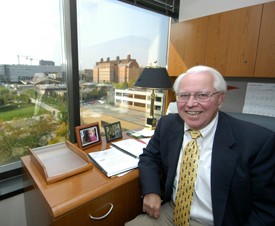
Steger Left Legacy at UC
Over a 19-year term as president of the University of Cincinnati,
left a formidable legacy:
1) Strategic Academic Vision
As outlined in two presidential reports (Harnessing the Intellect (1994) and The Lighting of a Fire (1998)), Steger set forth an agenda of strategic themes to guide the university into the future. Among the themes he identified were:
- the growing primacy of learning over teaching
- the increasingly interdisciplinary nature of learning
- the impact of technology upon learning
- the necessity of incorporating the entire world into learning
Among the outcomes of this strategic vision was a $1 billion renovation of the campus to accommodate technology and encourage interdisciplinary cooperation, the expansion of the cooperative education program to international locations, the creation of interdisciplinary academic programs such as biomedical engineering, and a massive effort to retrain faculty for effectiveness in todays technological environment.
2) Improved Metrics
While much public attention (New York Times, USA Today, Chronicle of Higher Education, etc.) focused on the rebirth of our campus and athletics, Steger presided over a series of significant shifts in key institutional rankings that indicated changes more substantial than cosmetic:
- Association of Research Libraries rank improved from 78 to 56
- National Science Foundation R&D rank improved from 75 to 50
- Total Federal R&D expenditures rank increased from 76 to 56
- Ranked 32 among Yahoo! Magazines Most Wired Colleges
3) Commitment to Learning and Teaching
Under Steger, the University of Cincinnati positioned itself nationally as a center for pedagogy, not simply teaching but a commitment to examining what is taught, how it is taught and whether anyone really learns anything. To fulfill this mission, the president launched a "Pedagogy Initiative" to explore new and more effective ways to encourage student learning. The Pedagogy Initiative included assessment of student success as well as faculty development and using good teaching tools.
4) Connections to the Cincinnati Community
Steger assumed a leadership role in two blue-ribbon task forces within the city, a commission empaneled to provide guidance to the city school district, and another to advise the city on infrastructure improvements. His participation in the former led to a complete restructuring of the universitys teacher-education program in collaboration with the city district. He has been instrumental in creating several business incubators, one in conjunction with the State of Ohio, and others within the university. He has led the economic development task force of a regional strategic planning exercise.
5) Cutting Costs, Raising Funds
Over the course of the 1990s, Steger managed cost reductions totaling over $100 million. To achieve this goal, he encouraged innovation within administrative and academic departments. One example was substantial savings in energy costs realized through a return-on-investment strategy, which had the auxiliary effect of earning the university federal recognition for reducing pollution. A substantial investment in faculty development was distributed competitively to faculty, with peer-reviewed assurance that innovation and excellence were clearly demonstrated. When he took office, the endowment amounted to less than $150 million dollars, but surpassed $1 billion dollars by the time he retired. His participation was essential in the Campaign for UC that raised $328 Million ($28 Million over target).
6) Globalization
Steger led the effort to build requirements for the study of international cultures into the University of Cincinnati undergraduate curriculum. During his term, the university attracted students from more than 100 countries each year. He initiated a series of 50 sister-university agreements in 23 countries and by having UC faculty conduct research or teach in more than 100 countries. Under Stegers leadership, the cooperative education program was expanded to international scope, placing UC students in jobs in Japan and Germany.
Related Stories
UC 1819 sewer tech startup makes a $7.5 million splash
March 31, 2025
A pioneering startup that emerged from the University of Cincinnati 1819 Innovation Hub’s Venture Lab pre-accelerator program in 2018, was recently acquired by global solutions provider IDEX Corporation for $7.5 million. Subterra, founded by Robert Lee, revolutionizes sewer and pipeline infrastructure monitoring through its innovative, AI-driven technology, which aligns with IDEX’s family of business solutions.
South by Southwest innovators break down the future of...
March 31, 2025
Top tech and media leaders congregated at South by Southwest 2025 to speak of the future of storytelling and offer tips. Below are our takeaways from four of the festival’s highlight sessions.
References on a resume: Everything you need to know
A strong professional reference can help demonstrate your qualifications and give you an edge over other job candidates. Find best practices and frequently asked questions about references.
